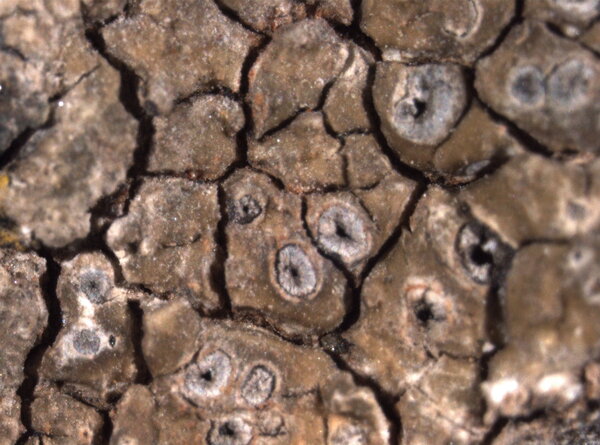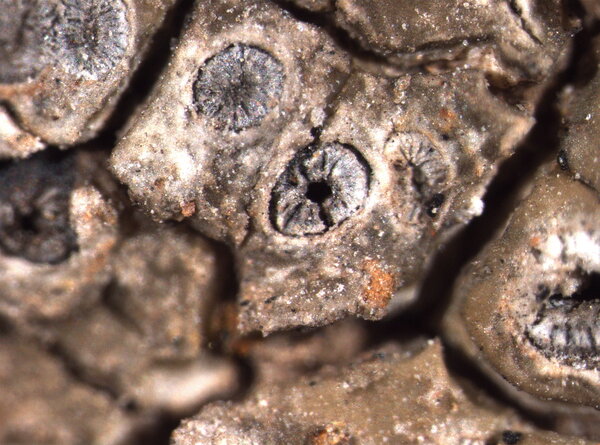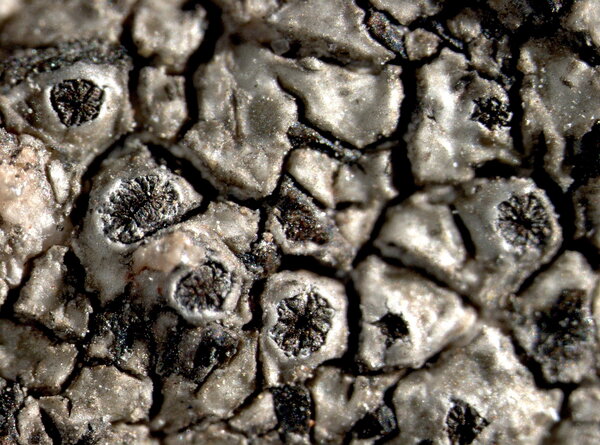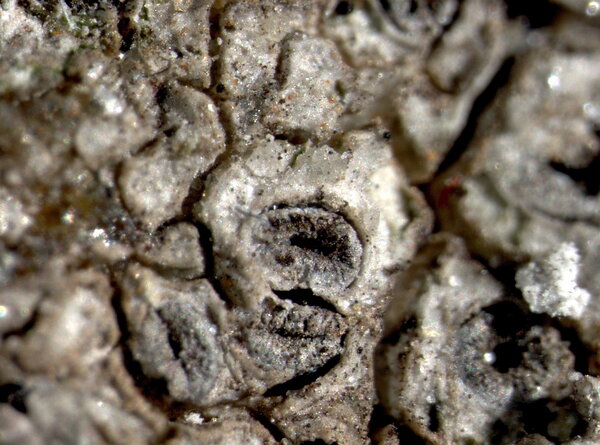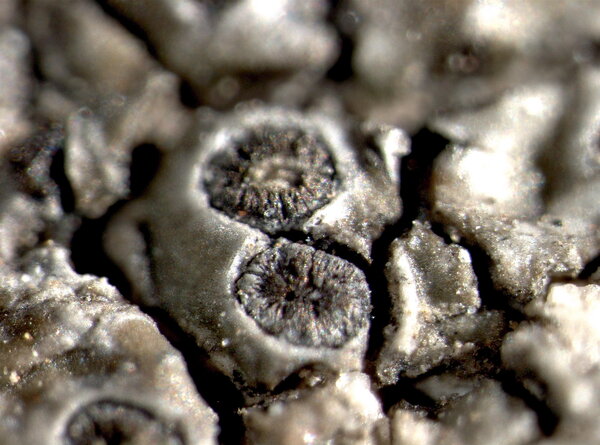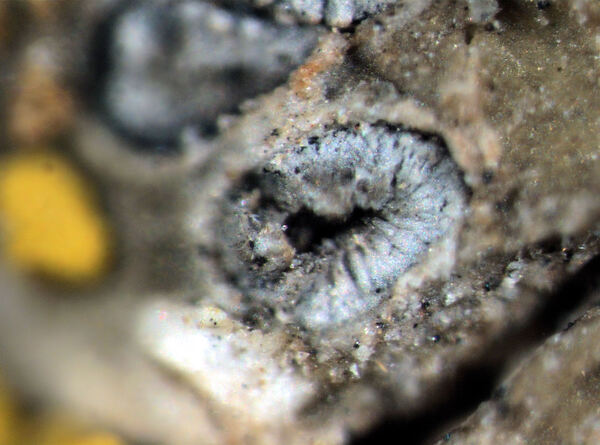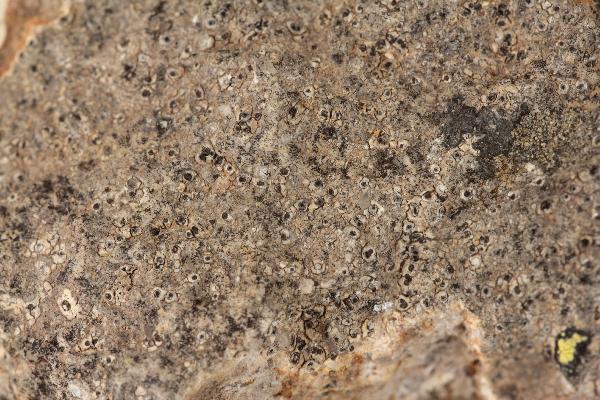Diploschistes euganeus (A. Massal.) J. Steiner
Verh. zool.-bot. Ges. Wien, 69: 96, 1919. Basionym: Limboria euganea A. Massal. - Ric. Auton. Lich. Crost.: 155, 1852.
Synonyms: Diploschistes clausus (Flot.) Zahlbr.; Urceolaria euganea (A. Massal.) Jatta; Urceolaria subsordida Nyl.
Distribution: N - Ven (Lazzarin 2000b), TAA, Lomb (De Vita & Valcuvia 2004), Emil (Fariselli & al. 2020), Lig (Valcuvia & al. 2000). C - Tosc, Laz, Sar (Rizzi & al. 2011). S - Camp (Nimis & Tretiach 2004), Bas (Nimis & Tretiach 1999), Cal (Nimis & Puntillo 2003, Puntillo 2011), Si.
Description: Thallus crustose, episubstratic, continuous to usually rimose-areolate, grey to brownish grey, smooth, dull or slightly shiny, epruinose, consisting of irregularly angular, 0.3-1.5 mm wide and 0.15-0.9(-1.3) mm thick areoles. Medulla white, I-. Apothecia perithecioid, immersed to semi-immersed in the areoles, up to 1.8 mm across (in section), with a blackish but sometimes white-pruinose, at first urceolate then flat disc which is not always visible from above, being concealed by a thick, entire or usually radially sulcate proper margin; thalline margin thin, poorly visible. Proper exciple carbonized, 70-90 µm thick, pseudoparenchymatous; epithecium poorly differentiated, colourless to brownish; hymenium colourless, 100-140 µm high, non-amyloid; paraphyses simple, flexuose, 1-1.5 µm thick, not swollen at apex. Asci (6-)8-spored, subclavate, the wall evenly thickened, with an abrupt apical thickening and a thin internal apical beak, lacking an apical apparatus. Ascospores muriform, with 3-6 transverse and 1-4 longitudinal septa, at first hyaline, then turning brown, broadly ellipsoid to subglobose, (16-)20-30(-32) x (10-)12-18(-20) µm. Photobiont chlorococcoid. Spot tests: K-, C-, KC-, P-, UV-. Chemistry: without lichen substances. Note: a mild-temperate lichen found on basic siliceous rocks, more rarely on brick and roofing tiles, in warm-humid areas, sometimes starting the life-cycle on Ochrolechia parella; most frequent in Tyrrhenian Italy.
Growth form: Crustose
Substrata: rocks
Photobiont: green algae other than Trentepohlia
Reproductive strategy: mainly sexual
paras (occasionally) of Ochrolechia parella when young
Commonnes-rarity: (info)
Alpine belt: absent
Subalpine belt: absent
Oromediterranean belt: absent
Montane belt: absent
Submediterranean belt: extremely rare
Padanian area: absent
Humid submediterranean belt: rather rare
Humid mediterranean belt: rare
Dry mediterranean belt: absent
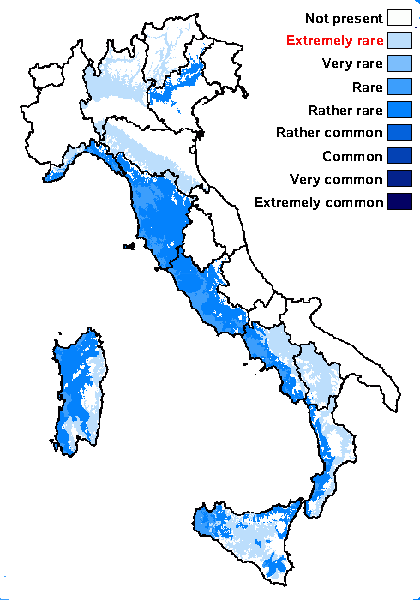
Predictive model
Herbarium samples
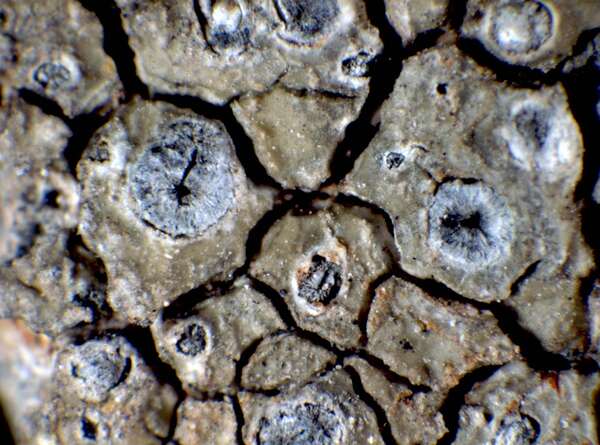

P.L. Nimis; Owner: Department of Life Sciences, University of Trieste
Herbarium: TSB (11585)
2001/11/24
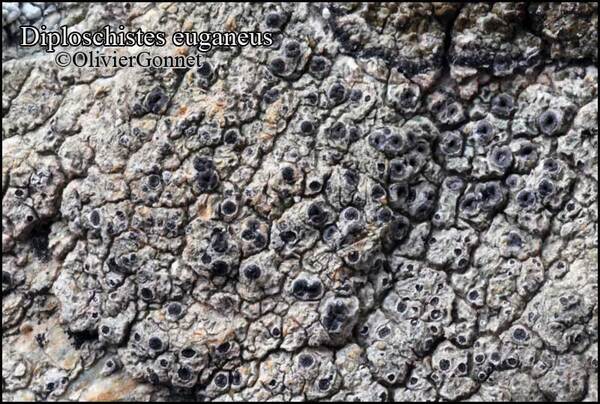
Courtesy Danièle et Olivier Gonnet - Source: https://www.afl-lichenologie.fr/Photos_AFL/Photos_AFL_D/Textes_D1/Diploschistes_euganeus.htm
France, Cap corse tour d'Agnello - Corse
20/11/2012
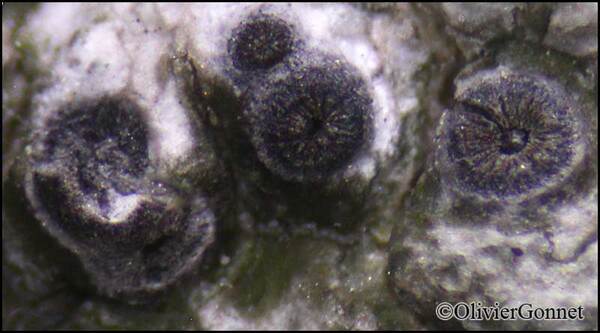
Courtesy Danièle et Olivier Gonnet - Source: https://www.afl-lichenologie.fr/Photos_AFL/Photos_AFL_D/Textes_D1/Diploschistes_euganeus.htm
France, Cap corse tour d'Agnello - Corse
20/11/2012
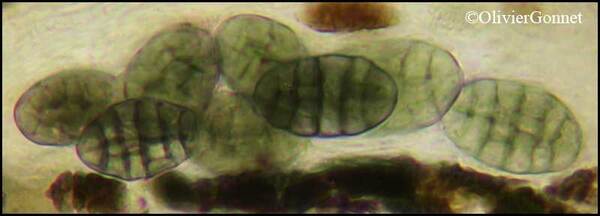
Courtesy Danièle et Olivier Gonnet - Source: https://www.afl-lichenologie.fr/Photos_AFL/Photos_AFL_D/Textes_D1/Diploschistes_euganeus.htm
France, Cap corse tour d'Agnello - Corse
20/11/2012


Felix Schumm - CC BY-SA 4.0
[ABL79329], Brazil, Rio Grande do Sul, Cangaçu, Florida , on exposed
siliceous rock. 31°04'38'' S, 52°37'28'' W, 245 m. Leg. A. Aptroot (no
79329), 16 July 2019, det. A. Aptroot 2019. - Spores 13 x 6 μm. -
Apothecia immersed. Spores muriform, 3-6 transveral and 1-4 longitudinal
septa, 16-32 x 10-20 μm. Chemistry: K-, C-, P-, UV-; no lichen
substances detected by TLC.
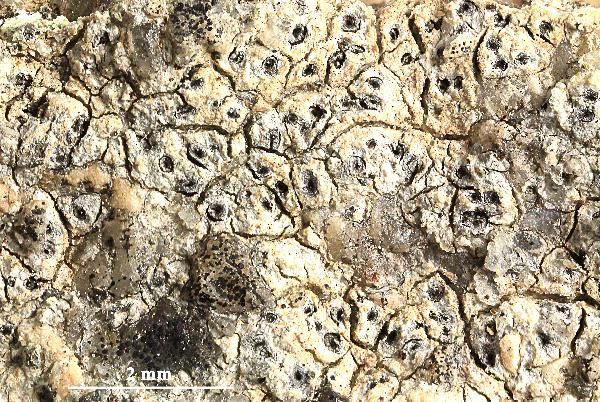

Felix Schumm - CC BY-SA 4.0
[ABL79329], Brazil, Rio Grande do Sul, Cangaçu, Florida , on exposed
siliceous rock. 31°04'38'' S, 52°37'28'' W, 245 m. Leg. A. Aptroot (no
79329), 16 July 2019, det. A. Aptroot 2019. - Spores 13 x 6 μm. -
Apothecia immersed. Spores muriform, 3-6 transveral and 1-4 longitudinal
septa, 16-32 x 10-20 μm. Chemistry: K-, C-, P-, UV-; no lichen
substances detected by TLC.
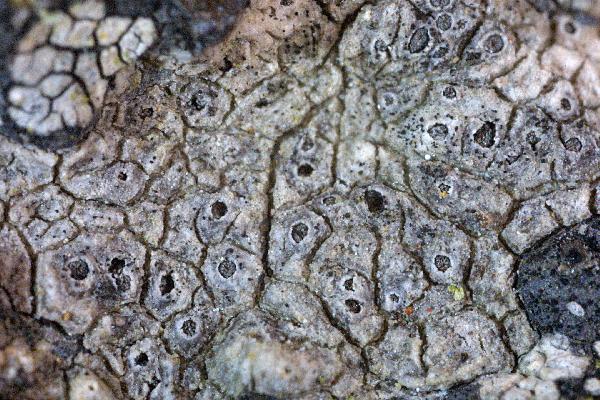

Felix Schumm - CC BY 4.0
[11217], Portugal, Azoren, Sao Miguel: An schwarzen Lavafelsen bei
der Küste von Mosteiros bei Beira - Mar de Baixo; 37°53.320' N,
25°49.426' W, 0 m. Leg. F. Schumm, 06.06.2003, det. F. Schumm,
11.2003. - Thallus K-, C-, KC-, P-; Sporen dunkel, muriform, 4-6 je
Ascus, 28,3 x 16,4 μm.
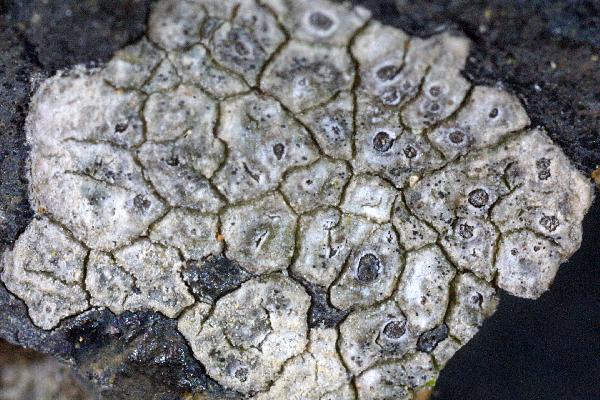

Felix Schumm - CC BY 4.0
[11217], Portugal, Azoren, Sao Miguel: An schwarzen Lavafelsen bei
der Küste von Mosteiros bei Beira - Mar de Baixo; 37°53.320' N,
25°49.426' W, 0 m. Leg. F. Schumm, 06.06.2003, det. F. Schumm,
11.2003. - Thallus K-, C-, KC-, P-; Sporen dunkel, muriform, 4-6 je
Ascus, 28,3 x 16,4 μm.
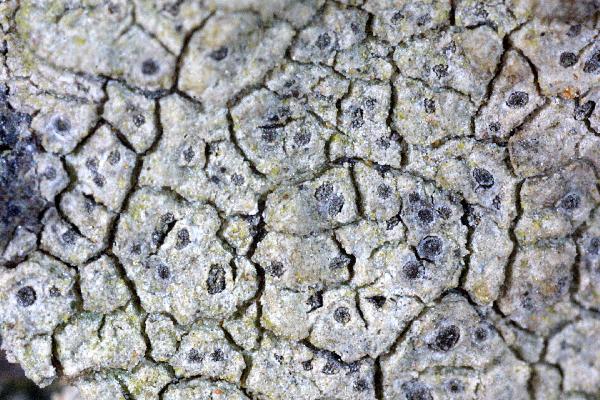

Felix Schumm - CC BY 4.0
[11217], Portugal, Azoren, Sao Miguel: An schwarzen Lavafelsen bei
der Küste von Mosteiros bei Beira - Mar de Baixo; 37°53.320' N,
25°49.426' W, 0 m. Leg. F. Schumm, 06.06.2003, det. F. Schumm,
11.2003. - Thallus K-, C-, KC-, P-; Sporen dunkel, muriform, 4-6 je
Ascus, 28,3 x 16,4 μm.


Felix Schumm - CC BY 4.0
[11217], Portugal, Azoren, Sao Miguel: An schwarzen Lavafelsen bei
der Küste von Mosteiros bei Beira - Mar de Baixo; 37°53.320' N,
25°49.426' W, 0 m. Leg. F. Schumm, 06.06.2003, det. F. Schumm,
11.2003. - Thallus K-, C-, KC-, P-; Sporen dunkel, muriform, 4-6 je
Ascus, 28,3 x 16,4 μm.
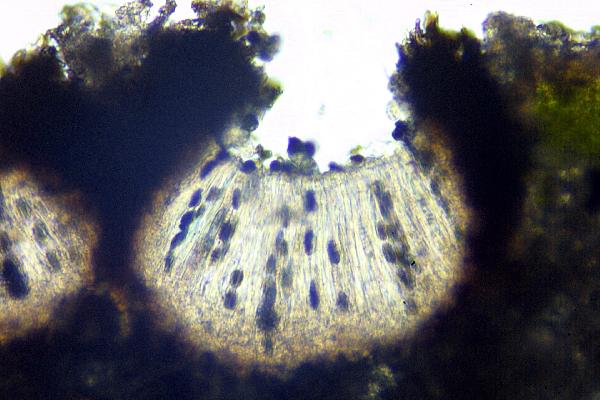

Felix Schumm - CC BY 4.0
[11217], Portugal, Azoren, Sao Miguel: An schwarzen Lavafelsen bei
der Küste von Mosteiros bei Beira - Mar de Baixo; 37°53.320' N,
25°49.426' W, 0 m. Leg. F. Schumm, 06.06.2003, det. F. Schumm,
11.2003. - Thallus K-, C-, KC-, P-; Sporen dunkel, muriform, 4-6 je
Ascus, 28,3 x 16,4 μm.
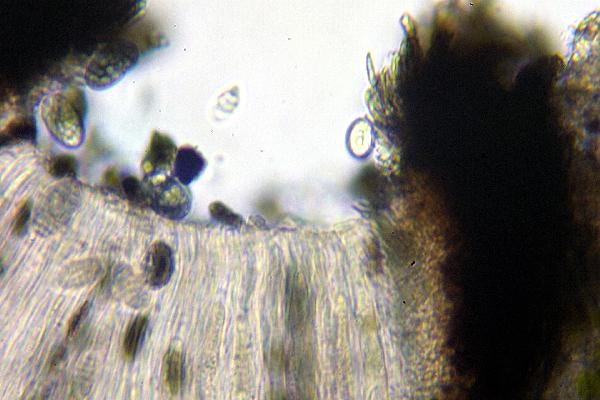

Felix Schumm - CC BY 4.0
[11217], Portugal, Azoren, Sao Miguel: An schwarzen Lavafelsen bei
der Küste von Mosteiros bei Beira - Mar de Baixo; 37°53.320' N,
25°49.426' W, 0 m. Leg. F. Schumm, 06.06.2003, det. F. Schumm,
11.2003. - Thallus K-, C-, KC-, P-; Sporen dunkel, muriform, 4-6 je
Ascus, 28,3 x 16,4 μm.
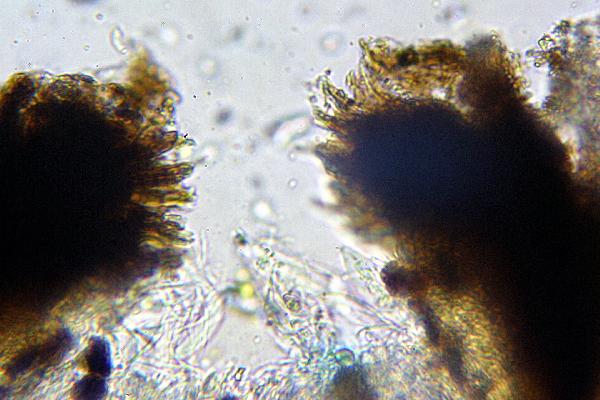

Felix Schumm - CC BY 4.0
[11217], Portugal, Azoren, Sao Miguel: An schwarzen Lavafelsen bei
der Küste von Mosteiros bei Beira - Mar de Baixo; 37°53.320' N,
25°49.426' W, 0 m. Leg. F. Schumm, 06.06.2003, det. F. Schumm,
11.2003. - Thallus K-, C-, KC-, P-; Sporen dunkel, muriform, 4-6 je
Ascus, 28,3 x 16,4 μm.
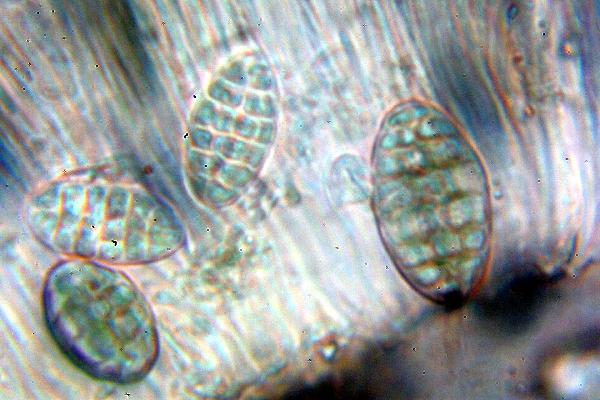

Felix Schumm - CC BY 4.0
[11217], Portugal, Azoren, Sao Miguel: An schwarzen Lavafelsen bei
der Küste von Mosteiros bei Beira - Mar de Baixo; 37°53.320' N,
25°49.426' W, 0 m. Leg. F. Schumm, 06.06.2003, det. F. Schumm,
11.2003. - Thallus K-, C-, KC-, P-; Sporen dunkel, muriform, 4-6 je
Ascus, 28,3 x 16,4 μm.
Growth form: Crustose
Substrata: rocks
Photobiont: green algae other than Trentepohlia
Reproductive strategy: mainly sexual
paras (occasionally) of Ochrolechia parella when young
Commonnes-rarity: (info)
Alpine belt: absent
Subalpine belt: absent
Oromediterranean belt: absent
Montane belt: absent
Submediterranean belt: extremely rare
Padanian area: absent
Humid submediterranean belt: rather rare
Humid mediterranean belt: rare
Dry mediterranean belt: absent

Predictive model
| Herbarium samples |


P.L. Nimis; Owner: Department of Life Sciences, University of Trieste
Herbarium: TSB (11585)
2001/11/24

Courtesy Danièle et Olivier Gonnet - Source: https://www.afl-lichenologie.fr/Photos_AFL/Photos_AFL_D/Textes_D1/Diploschistes_euganeus.htm
France, Cap corse tour d'Agnello - Corse
20/11/2012

Courtesy Danièle et Olivier Gonnet - Source: https://www.afl-lichenologie.fr/Photos_AFL/Photos_AFL_D/Textes_D1/Diploschistes_euganeus.htm
France, Cap corse tour d'Agnello - Corse
20/11/2012

Courtesy Danièle et Olivier Gonnet - Source: https://www.afl-lichenologie.fr/Photos_AFL/Photos_AFL_D/Textes_D1/Diploschistes_euganeus.htm
France, Cap corse tour d'Agnello - Corse
20/11/2012


Felix Schumm - CC BY-SA 4.0
[ABL79329], Brazil, Rio Grande do Sul, Cangaçu, Florida , on exposed siliceous rock. 31°04'38'' S, 52°37'28'' W, 245 m. Leg. A. Aptroot (no 79329), 16 July 2019, det. A. Aptroot 2019. - Spores 13 x 6 μm. - Apothecia immersed. Spores muriform, 3-6 transveral and 1-4 longitudinal septa, 16-32 x 10-20 μm. Chemistry: K-, C-, P-, UV-; no lichen substances detected by TLC.


Felix Schumm - CC BY-SA 4.0
[ABL79329], Brazil, Rio Grande do Sul, Cangaçu, Florida , on exposed siliceous rock. 31°04'38'' S, 52°37'28'' W, 245 m. Leg. A. Aptroot (no 79329), 16 July 2019, det. A. Aptroot 2019. - Spores 13 x 6 μm. - Apothecia immersed. Spores muriform, 3-6 transveral and 1-4 longitudinal septa, 16-32 x 10-20 μm. Chemistry: K-, C-, P-, UV-; no lichen substances detected by TLC.


Felix Schumm - CC BY 4.0
[11217], Portugal, Azoren, Sao Miguel: An schwarzen Lavafelsen bei der Küste von Mosteiros bei Beira - Mar de Baixo; 37°53.320' N, 25°49.426' W, 0 m. Leg. F. Schumm, 06.06.2003, det. F. Schumm, 11.2003. - Thallus K-, C-, KC-, P-; Sporen dunkel, muriform, 4-6 je Ascus, 28,3 x 16,4 μm.


Felix Schumm - CC BY 4.0
[11217], Portugal, Azoren, Sao Miguel: An schwarzen Lavafelsen bei der Küste von Mosteiros bei Beira - Mar de Baixo; 37°53.320' N, 25°49.426' W, 0 m. Leg. F. Schumm, 06.06.2003, det. F. Schumm, 11.2003. - Thallus K-, C-, KC-, P-; Sporen dunkel, muriform, 4-6 je Ascus, 28,3 x 16,4 μm.


Felix Schumm - CC BY 4.0
[11217], Portugal, Azoren, Sao Miguel: An schwarzen Lavafelsen bei der Küste von Mosteiros bei Beira - Mar de Baixo; 37°53.320' N, 25°49.426' W, 0 m. Leg. F. Schumm, 06.06.2003, det. F. Schumm, 11.2003. - Thallus K-, C-, KC-, P-; Sporen dunkel, muriform, 4-6 je Ascus, 28,3 x 16,4 μm.


Felix Schumm - CC BY 4.0
[11217], Portugal, Azoren, Sao Miguel: An schwarzen Lavafelsen bei der Küste von Mosteiros bei Beira - Mar de Baixo; 37°53.320' N, 25°49.426' W, 0 m. Leg. F. Schumm, 06.06.2003, det. F. Schumm, 11.2003. - Thallus K-, C-, KC-, P-; Sporen dunkel, muriform, 4-6 je Ascus, 28,3 x 16,4 μm.


Felix Schumm - CC BY 4.0
[11217], Portugal, Azoren, Sao Miguel: An schwarzen Lavafelsen bei der Küste von Mosteiros bei Beira - Mar de Baixo; 37°53.320' N, 25°49.426' W, 0 m. Leg. F. Schumm, 06.06.2003, det. F. Schumm, 11.2003. - Thallus K-, C-, KC-, P-; Sporen dunkel, muriform, 4-6 je Ascus, 28,3 x 16,4 μm.


Felix Schumm - CC BY 4.0
[11217], Portugal, Azoren, Sao Miguel: An schwarzen Lavafelsen bei der Küste von Mosteiros bei Beira - Mar de Baixo; 37°53.320' N, 25°49.426' W, 0 m. Leg. F. Schumm, 06.06.2003, det. F. Schumm, 11.2003. - Thallus K-, C-, KC-, P-; Sporen dunkel, muriform, 4-6 je Ascus, 28,3 x 16,4 μm.


Felix Schumm - CC BY 4.0
[11217], Portugal, Azoren, Sao Miguel: An schwarzen Lavafelsen bei der Küste von Mosteiros bei Beira - Mar de Baixo; 37°53.320' N, 25°49.426' W, 0 m. Leg. F. Schumm, 06.06.2003, det. F. Schumm, 11.2003. - Thallus K-, C-, KC-, P-; Sporen dunkel, muriform, 4-6 je Ascus, 28,3 x 16,4 μm.


 INDEX FUNGORUM
INDEX FUNGORUM
 GBIF
GBIF
 DOLICHENS
DOLICHENS
